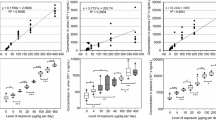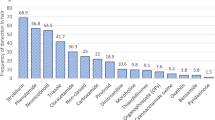Abstract
Although the relationship between chemical intake and resulting concentration in hair remains incompletely elucidated, the transfer from blood to hair bulb living cells is generally considered the main route of incorporation. The present work investigated the correlation between blood and hair concentration of 23 pesticides/metabolites from different chemical classes in rats submitted to chronic controlled exposure. Long-Evans rats were administered pesticides by gavage three times per week over a 90-day period. After hair sample decontamination, pulverization, and extraction, compounds were analyzed by gas chromatography tandem mass spectrometry (GC-MS/MS). Blood was collected at sacrifice, immediately turned into plasma, and analyzed after extraction for the same compounds by GC-MS/MS. The data obtained for all the investigated compounds demonstrated significant association between plasma and hair concentrations (P value of 2.97E−45 and R Pearson of 0.875), with the exception of three outliers. For all the target compounds, water solubility, lipophilicity, molecular weight, and charge were therefore investigated in order to understand the role of these parameters in outliers’ specific behavior. Although a possible change in the charge through the transfer from blood to hair might be suspected for two outliers, on the whole the physicochemical parameters investigated here did not seem to influence incorporation of chemicals into hair. Our results support that the concentration of chemicals in hair mainly depends on the respective concentration in plasma and suggest that for most compounds, the transfer from blood to hair would not represent a limiting step in the incorporation.

Pesticide concentration in plasma vs hair




Similar content being viewed by others
References
EFSA. Literature review on epidemiological studies linking exposure to pesticides and health effects. 2013.
Kintz P, Salomone A, Vincenti M. Hair analysis in clinical and forensic toxicology. Amsterdam: Elsevier; 2015.
Ferko AP, Barbieri EJ, DiGregorio GJ, Ruch EK. The accumulation and disappearance of cocaine and benzoylecgonine in rat hair following prolonged administration of cocaine. Life Sci. 1992;51(23):1823–32.
Scheidweiler KB, Cone EJ, Moolchan ET, Huestis MA. Dose-related distribution of codeine, cocaine, and metabolites into human hair following controlled oral codeine and subcutaneous cocaine administration. J Pharmacol Exp Ther. 2005;313(2):909–15.
Appenzeller BM, Agirman R, Neuberg P, Yegles M, Wennig R. Segmental determination of ethyl glucuronide in hair: a pilot study. Forensic Sci Int. 2007;173(2-3):87–92.
Schramm KW. Hair—biomonitoring of organic pollutants. Chemosphere. 2008;72(8):1103–11.
Nakao T, Aozasa O, Ohta S, Miyata H. Assessment of human exposure to PCDDs, PCDFs and co-PCBs using hair as a human pollution indicator sample I: development of analytical method for human hair and evaluation for exposure assessment. Chemosphere. 2002;48(8):885–96.
Altshul L, Covaci A, Hauser R. The relationship between levels of PCBs and pesticides in human hair and blood: preliminary result. Environ Health Perspect. 2004;112(11):1193–9.
Nakahara Y. Hair analysis for abused and therapeutic drugs. J Chromatogr B Biomed Sci Appl. 1999;733(1-2):161–80.
Nakahara Y, Hanajiri R. Hair analysis for drugs of abuse XXI. Effect of para-substituents on benzene ring of methamphetamine on drug incorporation into rat hair. Life Sci. 2000;66(7):563–74.
Nakahara Y, Kikura R. Hair analysis for drugs of abuse. VII. The incorporation rates of cocaine, benzoylecgonine and ecgonine methyl ester into rat hair and hydrolysis of cocaine in rat hair. Arch Toxicol. 1994;68(1):54–9.
Nakahara Y, Ochiai T, Kikura R. Hair analysis for drugs of abuse. V. The facility in incorporation of cocaine into hair over its major metabolites, benzoylecgonine and ecgonine methyl ester. Arch Toxicol. 1992;66(6):446–9.
Scott KS, Nakahara Y. A study into the rate of incorporation of eight benzodiazepines into rat hair. Forensic Sci Int. 2003;133(1-2):47–56.
Kintz P. Traité de toxicologie médico-judiciaire. 2e édition ed: Elsevier Masson; 2012.
Hardy EM, Duca RC, Salquebre G, Appenzeller BM. Multi-residue analysis of organic pollutants in hair and urine for matrices comparison. Forensic Sci Int. 2015;249:6–19.
Toxic Substances Portal [updated December 12, 2014]. December 12, 2014: Available from: http://www.atsdr.cdc.gov/toxprofiles/index.asp.
The Pesticide Properties Database (PPDB).
The Toxine and Toxin Target Database (T3DB).
Ruiz-Suarez LE, Castro-Chan RA, Rivero-Perez NE, Trejo-Acevedo A, Guillen-Navarro GK, Geissen V, et al. Levels of organochlorine pesticides in blood plasma from residents of malaria-endemic communities in Chiapas, Mexico. Int J Environ Res Public Health. 2014;11(10):10444–60.
Curren MS, Davis K, Liang CL, Adlard B, Foster WG, Donaldson SG, et al. Comparing plasma concentrations of persistent organic pollutants and metals in primiparous women from northern and southern Canada. Sci Total Environ. 2014;479-480:306–18.
Wittsiepe J, Nestola M, Kohne M, Zinn P, Wilhelm M. Determination of polychlorinated biphenyls and organochlorine pesticides in small volumes of human blood by high-throughput on-line SPE-LVI-GC-HRMS. J Chromatogr B Analyt Technol Biomed Life Sci. 2014;945-946:217–24.
Appenzeller BM, Tsatsakis AM. Hair analysis for biomonitoring of environmental and occupational exposure to organic pollutants: state of the art, critical review and future needs. Toxicol Lett. 2012;210(2):119–40.
Ratelle M, Cote J, Bouchard M. Time profiles and toxicokinetic parameters of key biomarkers of exposure to cypermethrin in orally exposed volunteers compared with previously available kinetic data following permethrin exposure. J Appl Toxicol. 2015.
Thiphom S, Prapamontol T, Chantara S, Mangklabruks A, Suphavilai C, Ahn KC, et al. Determination of the pyrethroid insecticide metabolite 3-PBA in plasma and urine samples from farmer and consumer groups in northern Thailand. J Environ Sci Health B. 2014;49(1):15–22.
Moser VC, Stewart N, Freeborn DL, Crooks J, MacMillan DK, Hedge JM, et al. Assessment of serum biomarkers in rats after exposure to pesticides of different chemical classes. Toxicol Appl Pharmacol. 2015;282(2):161–74.
Appenzeller B M R Hardy E M, Grova N, Chata C, Fays F, Briand O, Schroeder H, Duca R. hair analysis for the biomonitoring of pesticide exposure—comparison with blood and 24h-urine in an animal model. Submitted. 2015.
Nakahara Y, Takahashi K, Kikura R. Hair analysis for drugs of abuse. X. Effect of physicochemical properties of drugs on the incorporation rates into hair. Biol Pharm Bull. 1995;18(9):1223–7.
Nakahara Y, Kikura R. Hair analysis for drugs of abuse. XIII. Effect of structural factors on incorporation of drugs into hair: the incorporation rates of amphetamine analogs. Arch Toxicol. 1996;70(12):841–9.
Pragst F, Balikova MA. State of the art in hair analysis for detection of drug and alcohol abuse. Clin Chim Acta. 2006;370(1-2):17–49.
Kintz P. Analytical and practical aspects of drug testing in hair. Boca Raton: CRC Press; 2007. 382 p.
Nakahara Y. Detection and diagnostic interpretation of amphetamines in hair. Forensic Sci Int. 1995;70(1-3):135–53.
Acknowledgments
This study co-financed through the call for research project 2010 of the national program “Environmental and Occupational Health” (PNR EST) of the French Agency for Food, Environmental and Occupational Health Safety (ANSES), with the financial support of the Office National de l’Eau et des Milieux Aquatiques (ONEMA) supporting the implementation of the Plan Ecophyto 2018, France.
Caroline Chata benefited from a PhD grant from the Fonds National de la Recherche (FNR) (AFR 7009593), Luxembourg.
Author information
Authors and Affiliations
Corresponding author
Ethics declarations
Conflict of interest
The authors declare that they have no conflict of interest.
Electronic supplementary material
Below is the link to the electronic supplementary material.
ESM 1
(PDF 178 kb)
Rights and permissions
About this article
Cite this article
Chata, C., M. Hardy, E., Grova, N. et al. Influence of pesticide physicochemical properties on the association between plasma and hair concentration. Anal Bioanal Chem 408, 3601–3612 (2016). https://doi.org/10.1007/s00216-016-9442-y
Received:
Revised:
Accepted:
Published:
Issue Date:
DOI: https://doi.org/10.1007/s00216-016-9442-y




